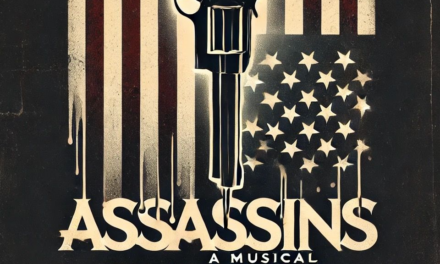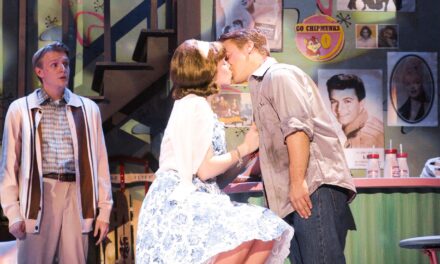SALT LAKE CITY — When Almost, Maine by John Cariani premiered at Portland Stage Company it was a smash success. Its premier off-Broadway in January of 2006, however, was less successful; the show closed after only one month. It is easy to see how the piece could be easily tossed aside as shallow silliness, but when produced well, I believe this play can be very effective. The effectiveness of the play is evident from the over 600 productions staged in the United States alone in the last six years. It has become a favorite in high schools, colleges and community theaters all over the world. And it is easy to see why.
The play is a composition of nine short plays, each exploring the love and loss between nine different couples in the not-quite town of Almost, Maine. The writing is witty and charming. Cariani takes a whimsical approach to love that is not always based in reality. The play can be a delightful and fun or cliché and tacky, depending on the approach of the director. Fortunately, Westminster’s production leaned toward the delightful side.
Almost, Maine is really the perfect play for Westminster Theatre Society. The play’s simplicity was definitely a plus considering the company had a mere three weeks to put the production together. The staff was friendly and casual, which set the mood for a play that doesn’t take itself too seriously. The intimate space in the Dumke Theatre lent itself well to the play as well. Natalie Colony’s set was simple, yet professional. She was not afraid of leaving things bare and open. The one scenic unit she designed was the front door and porch of a house, and when turned around served as both the inside of a house or restaurant. The unit was easily movable and could be placed at different places on stage. What could have been a long night of endless scene changes was made quick and painless thanks to a very efficient deck crew. Lighting designer Joseph Cook also did a great job. His choices were bold but effective. Cook’s design included tiny lights on the back curtain that resembled a night sky, and even mimicked the look of the northern lights when the curtain moved. I was most pleased, however, with Morgan Hirschel’s sound design. Her selection of music, both preshow and between scenes, was perfect and her various sound effects throughout the play (cars driving, crowds talking) added just the right touch of reality. The sound design did its job perfectly, to set the mood and support the action, without being noticed too much.
Pleased as I was with the technical aspects of the show, I was disappointed when the performance of the actors didn’t quite live up to the nearly flawless artistic design. A piece like this can be incredibly challenging for an actor. The audience is literally feet away from the performers, who have very little set to rely upon. In these situations, the only thing the actors can really rely upon is their fellow cast members. This, I believe, is where the cast missed their mark.
I got a sense of disconnectedness in many of the scenes. The actors seemed to be playing the scenes alone, instead of working with each other. This was prominent in Scene Four, titled “Getting It Back.” In this scene, Gayle (played by Mayra Smith) has decided to end her relationship with Lendall (played by Michael Calcino). This scene could be the best in the play because it’s written to be funny and ultimately heartwarming. Unfortunately the scene fell flat. There seemed to be nothing at stake between the characters. Calcino’s character in particular seemed to not care whether the relationship succeeded for failed. The scene lacked heart and life.
This was not always the case, however. Several of the scenes shined above the others. One scene in particular that stood out to me was “They Fell.” In this scene, best friends Randy and Chad (played by Calacino and Nikola Muckajev respectively) realize they are in love with each other. Calacino, who struggled in the preceding scene, suddenly came to life opposite Muckajev. The scene was full of life of chemistry. The actors played off each other well and obviously enjoyed the scene. Another actor worth mentioning is Niklaas Duncan. His portrayals of both Pete and Steve were nearly flawless. He was able to capture his characters with ease and simplicity, trusting in the text to do its job.
Though her cast seemed disconnected at times, Sarah Hayes’ direction was commendable. A set of scenes on a nearly bare stage could easily be boring. But Hayes smartly kept the scenes active and interesting. Though the play lacked structure at times, her direction was simple in the best way. Although she gave the actors plenty of room to play, she might have focused more attention on the basics of live performance. There were times when the audience had trouble hearing or understanding the actors. As a director, Hayes could have stressed this importance.
The highlight of the night came in the final moments of the play. The final scene was exactly what I had been waiting for. Alison Lente’s portrayal of masculine, guarded Rhonda contrasted perfectly against Connor Montgomery’s nervous and gentle Dave. These actors, both seniors at Westminster, know what it means to be a scene partner. They played the scene together, giving and taking. Their chemistry left me grinning and wanting more. These are talented actors.
Though the cast’s performance isn’t perfect, the quality of the material wins out. The production is incredibly enjoyable thanks to great writing and great vision. I highly recommend that you catch Almost, Maine’s last performance (which is tonight). Plus, I think it’s worth the efforts for readers to look into Westminster Theater Society’s future productions for a professional, enjoyable night at the theatre.




